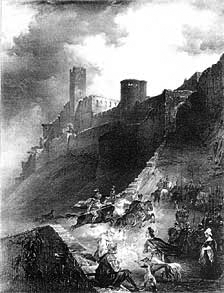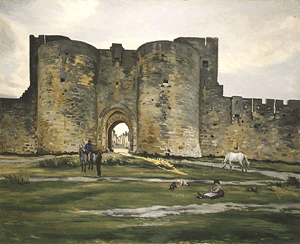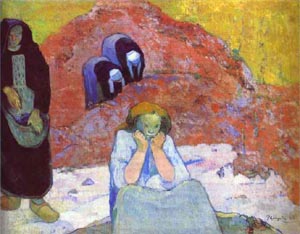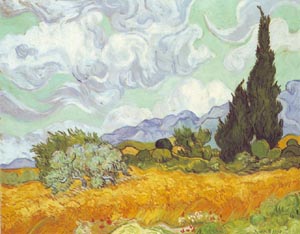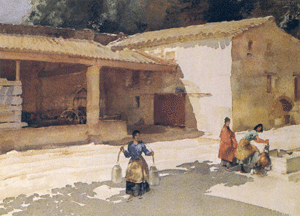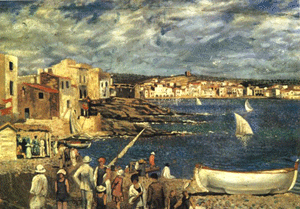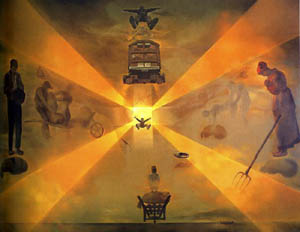Things to do in the Languedoc: Cultural
Activities: Art and Artists: Historic
Artists
Well known historic Languedoc artists: click on any of
the names below for more information and samples of their
work. (Click here for Contemporay
Artists and Art Festivals)
Prehistoric
cave painters
Greek,
Etruscan and Roman artists
The
Master of Cabestany - a medieval sculptor
Nicolas
Poussin (1594-1665)
Eugène
Emmanuel Viollet-le-Duc (1814 - 1879)
Jean-Paul
Laurens (1838 - 1921)
Jean
Frédéric Bazille (1841 - 1870)
Paul
Gauguin (1848 - 1903)
Vincent
van Gogh (1853 - 1890)
Marie
Petiet (1854 - 1893) & Etienne Dujardin-Beaumetz
Edouard
Bernard Debat-Ponsan (1847-1913)
Achille
Laugé (1861 - 1944)
Henri
Toulouse-Lautrec (1864 - 1901)
Charles
Rennie Mackintosh (1868 – 1928)
Henri
Matisse (1869 – 1954), Fauvist painter
André
Derain (1880 – 1954), Fauvist painter
Juan
Gris (1887 – 1927), Cubist painter
Sir
William Russell Flint (1880 - 1969)
Pablo
Picasso (1881 – 1973), Cubist painter
Georges Braque (1882-1963), Fauvist painter
Marc
Chagall (1887-1985)
René
Magritte (1898 - 1967)
Salvador Dali (1904 – 1989)>
Yves
Brayer (1907-1990)
Pierre
Soulages (1919 - )
Vincent
Bioulès (1938 - )
Manolo
Valdés (1942 - )
Vanilla
Beer (1950 - )
Catherine
Mascrès (1954 - )
Anthony
Murphy (1956 - )
Hervé
Di Rosa (1959 - )
Ellie
Clemens
Paul
Davison
Simon
Fletcher
Deev
Vanorbeek
Danielle
Eubank
Allison
Carmichael
Prehistoric Art in the Languedoc-Roussillon
Art has long been practiced in what is now the South
of France. There are some 200 cave paintings currently
known that date from prehistoric
times.
|
|
| Cave paintings at Chauvet-Pont-d'Arc
in the Ardèche to the north of the Languedoc
date from (30,000 - 25,000 years ago |
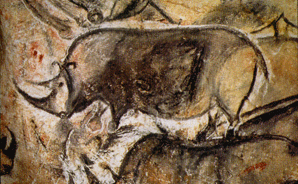 |
|
|
|
Ancient Art in the Languedoc-Roussillon
Greek,
Etruscan and Roman
art flourished here and can still be seen in ancient
Languedoc cities such as Nîmes.
|
|
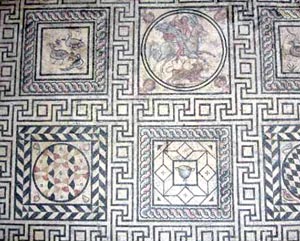 |
|
|
Medieval Art in the Languedoc-Roussillon
In the medieval period this was home to a sculptor
known to art historians as "The
Master of Cabestany". It was also home to
the troubadours
- and thus the cradle of modern western culture.
|
|
| Detail of the tympanum at Cabestany,
from which town the Master of Cabestany takes
his epithet. |
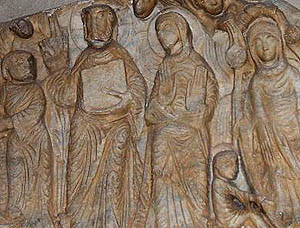 |
|
|
|
Nicolas Poussin
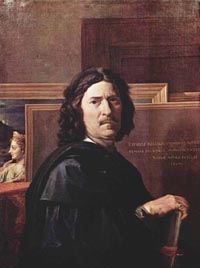  Nicolas
Poussin (15 June 1594 – 19 November 1665) was
a French painter in the classical style. His work
predominantly features clarity and order, and favouring
line over colour. He was the dominant inspiration
for classically oriented artists such as Jacques-Louis
David and Paul Cézanne. Nicolas
Poussin (15 June 1594 – 19 November 1665) was
a French painter in the classical style. His work
predominantly features clarity and order, and favouring
line over colour. He was the dominant inspiration
for classically oriented artists such as Jacques-Louis
David and Paul Cézanne.
He worked in Rome (for the Medici’s and Barberini)
and France. Louis XIII conferred on him the title
of First Painter in Ordinary. Among his works
are The Arcadian Shepherds (Et in Arcadia Ego)
around 1638. (shown right). This painting plays a
part in the famous Rennes-le-Château
mystery.
In 1643, Poussin went back to Rome. He suffered
from declining health after 1650, and was troubled
by a tremor in his hand, evidence of which is visible
in his late drawings. He died in Rome on November
19, 1665 and was buried in the church of San Lorenzo
in Lucina.
Poussin was a prolific artist. Initially, his genius
was recognized by only by small circles of collectors
(including Louis XIV.) He contributed a new theme
of "classical severity" to French art. Modern
art critics have suggested that the "analytic
Cubist" experiments of Pablo
Picasso and Georges
Braque were founded upon Poussin's example. Poussin's
paintings at the Louvre now reside in a gallery dedicated
to him.
|
|
Nicolas Poussin (1594-1665)
Et in Arcadia Ego: c. 1637 ?
Oil on canvas, 34 x 48 cm
Currently in the Louvre, Paris |
 |
|
|
|
Viollet-le-Duc
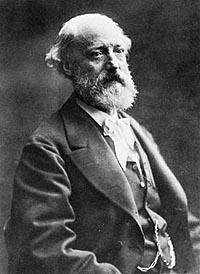  Eugène
Emmanuel Viollet-le-Duc (1814-1879) was a French architect
and restorer. He produced numerous spectacular architectural
drawings including many of Carcassonne
in the Aude
département for the restoration of which
he was largely responsible. Eugène
Emmanuel Viollet-le-Duc (1814-1879) was a French architect
and restorer. He produced numerous spectacular architectural
drawings including many of Carcassonne
in the Aude
département for the restoration of which
he was largely responsible.
Voyages pittoresques et romantiques dans l'ancienne
France is a multi-volume series on French architecture,
published 1820-1878, by the French novelist and poet
Charles Nodier, French author Alphonse de Cailleux,
and Belgian-born author and theater administrator
Isidore-Justin-Séverin Taylor. Viollet-le-Duc
executed 15 drawings; the remaining are by Pharamond
Blanchard, Claude Aimé Chenevard, Emile Desmaisons,
Joseph Marie Foussereau, Alexandrew Evariste Fragonard,
Emil Signol, and Antoine-Jean Weber.
You can find some of Viollet-le-Duc's drawings at
www.medieval
warfare.info
|
|
|
Charles
Nodier, J. Taylor, and Alphonse de Cailleux,
Château de Carcassonne, (c 1830, from
Voyages pittoresques et romantiques dans l'ancienne
France, Languedoc, Paris 1835)
Lithograph
|
|
|
|
|
|
Jean-Paul Laurens
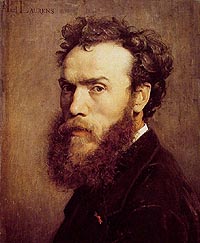  Jean-Paul
Laurens (1838 – 1921), was a French painter
and sculptor, and one of the last major exponents
of the French Academic style. Jean-Paul
Laurens (1838 – 1921), was a French painter
and sculptor, and one of the last major exponents
of the French Academic style.
Born in Fourquevaux, he was a pupil of Léon
Cogniet and Alexandre Bida. A Republican, his work
was often on historical and religious themes, through
which he sought to convey a message of opposition
to monarchical and clerical oppression. His erudition
and technical mastery were much admired in his time,
but in later years his hyper-realistic technique and
his theatrical mise-en-scène, were criticised.
His famous portrayal of "L'Excommunication de Robert
le Pieux" (Excommunication of Robert the Pious) (1875)
presents a dramatised version of the sanction imposed
on the king of France, guilty of having married his
distant cousin, Berthe. "L'Interdit" (The Interdict)
- painted in the same year - shows abandoned corpses
cut off from the grace of God outside a boarded up
chapel door where the sacraments are no longer delivered
- a warning about the ensuing disaster for France.
Repression of the Cathars
in the Languedoc was Laurens' second favourite theme.
It was through the character Bernard Délicieux,
a Franciscan friar and pretty much the only Catholic
Churchmen to have emerged from the persecution of
the Cathars with any honour, that Laurens resurrected
this part of French history. His inspiration came
from the Latin manuscript of the inquisition trials.
In "La Délivrance des emmurés de Carcassonne"
(Freeing of the imprisoned of Carcassonne) (1879,
Carcassonne
town hall), Laurens illustrated the riots caused by
the sermons of Délicieux, the Franciscan friar
who stood against the excesses of the religious courts
in the 1300s.
In a confrontation in "L'Agitateur du Languedoc"
(The Agitator of Languedoc) (1887) he is shown boldly
facing his judges.
The series is concluded with the painting "Après
la Question" (After the question) (1882), which soberly
portrays the mortal remains of the monk being taken
back to the dungeon after the torture.
The Inquisition is a theme that occurs in other works
by Laurens. Depicting the dangers of religious intolerance
and fanaticism, Laurens multiplied his variations
on this theme with, for example, Les Murailles du
Saint-Office (The walls of the Holy Office) (1883)
depicting the role of the pope's hidden advisor; Le
Pape et l'Inquisiteur (The Pope and the Inquisitor)
(1882) showing Sixtus IV with Torquemada who is examining
the Papal Bull making him Inquisitor General of Castilla
and Aragon in 1483; Le Grand Inquisiteur chez les
Rois catholiques (The Great Inquisitor in the time
of the Catholic kings) (1886) depicting the decision
to persecute Jews in the Spanish kingdom; Les Hommes
du Saint-Office (Men of the Holy Office) (1889) showing
the effectiveness of an entire institution at the
service of repression in this portrayal of Inquisitors
examining the files of those whose lives were in the
balance.
Laurens was commissioned to paint numerous public
works by the French Third Republic, including the
hall of distinguished citizens at the Capitol in Toulouse.
Laurens was a professor at the École nationale
supérieure des Beaux-Arts in Paris, He
died in Paris in 1921.
|
|
|
Jean-Paul
Laurens (1838-1921)
La Délivrance des emmurés de Carcassonne,
1879
oil on canvas ( 115 cm c 150 cm)
Musée des Beaux Arts, Carcassonne, France
|
|
|
|
Jean-Paul
Laurens (1838-1921)
The Agitator of Languedoc, 1882
oil on canvas ( 115 cm c 150 cm)
Musée des Augustins, Toulouse, France
|
|
|
|
|
|
Jean Frédéric Bazille
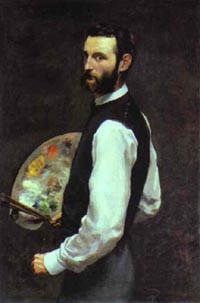  Jean
Frédéric Bazille (December 6, 1841 –
November 28, 1870) was a French Impressionist painter.
He was born in Montpellier
(in the Hérault
département) into a wealthy Protestant
family. He became interested in painting after seeing
some works of Eugène Delacroix. His family
agreed to let him study painting, but on condition
that he also study medicine. Jean
Frédéric Bazille (December 6, 1841 –
November 28, 1870) was a French Impressionist painter.
He was born in Montpellier
(in the Hérault
département) into a wealthy Protestant
family. He became interested in painting after seeing
some works of Eugène Delacroix. His family
agreed to let him study painting, but on condition
that he also study medicine.
Bazille began studying medicine in 1859, and moved
to Paris in 1862 to continue his studies. There he
met Pierre-Auguste Renoir, was drawn to Impressionist
painting, and began taking classes in Charles Gleyre's
studio. After failing his medical examination in 1864,
he began painting full-time. Close friends included
Claude Monet, Alfred Sisley, and Édouard Manet.
Bazille was generous with his wealth, and helped support
his less fortunate associates by giving them space
in his studio and materials to use. His best known
painting is Family Reunion of 1867–1868
(in the Musée d'Orsay, Paris).
The painting shown on the right depicts part of the
city wall of
Aigues Mortes in the Gard
département of the Languedoc-Roussillon.
Frédéric Bazille joined a Zouave regiment
in August 1870, after the outbreak of the Franco-Prussian
War. On November 28 of that year he was with his unit
at the Battle of Beaune-la-Rolande when he led an
assault on an enemy position. He was hit twice and
died on the battlefield at the age of twenty nine.
His father took his body back for burial at Montpellier
in
the Hérault
département.
|
|
|
Frédéric
Bazille.
Porte d'Aigues-Mortes, dite Porte de la Reine.
1867
Oil on Canvas 31.7 x 39.4 in. (80.5 x 100 cm).
|
|
|
|
|
|
Paul Gauguin

 Eugène
Henri Paul Gauguin (7 June 1848 – 8 May 1903)
was a leading Post-Impressionist painter. His experimentation
with colouring led directly to the Synthetist style
of modern art while his work under the influence of
the cloisonnist style paved the way to Primitivism
and the return to the pastoral. He was also an influential
practitioner of wood engraving and woodcuts as art
forms. Eugène
Henri Paul Gauguin (7 June 1848 – 8 May 1903)
was a leading Post-Impressionist painter. His experimentation
with colouring led directly to the Synthetist style
of modern art while his work under the influence of
the cloisonnist style paved the way to Primitivism
and the return to the pastoral. He was also an influential
practitioner of wood engraving and woodcuts as art
forms.
Paul Gauguin was born in Paris to journalist Clovis
Gauguin and half-Peruvian Aline Maria Chazal, daughter
of socialist leader Flora Tristan. In 1851 the family
left Paris for Peru, motivated by the political climate
of the period. At the age of seven, he and his family
returned to France, but imagery of Peru would later
influence his art.
Gauguin was interested in art since childhood. He
began painting at an early age. He would also visit
galleries and purchase work by emerging artists. Gauguin
formed a friendship with artist Camille Pissarro,
who introduced him to other artists. Gauguin rented
a studio and showed paintings in Impressionist exhibitions
held in 1881 and 1882. Over two summer vacations,
he painted with Pissarro and occasionally with Paul
Cézanne.
Like his friend Vincent
van Goghh, with whom he spent nine weeks painting
in Arles in 1888, Gauguin experienced depression and
at one time attempted suicide. He felt that traditional
European painting had become too imitative and lacked
symbolic depth. By contrast, the art of Africa and
Asia seemed to him to be full of mystic symbolism
and vigour. There was a vogue in Europe at the time
for the art of other cultures, especially that of
Japan. He was invited to participate in the 1889 exhibition
organized by Les XX.
Under the influence of folk art and Japanese prints,
Gauguin evolved towards Cloisonnism. Gauguin paid
little attention to classical perspective and eliminated
subtle gradations of colour, thereby dispensing with
the two most characteristic principles of post-Renaissance
art. His painting later evolved towards "Synthetism"
in which neither form nor colour predominate each
having an equal role.
In 1891, frustrated by lack of recognition at home
and financially destitute, Gauguin sailed to the tropics
to escape European civilisation and "everything
that is artificial and conventional.". Living
in Mataiea Village in Tahiti, he painted depictions
of Tahitian life. He moved to Punaauia in 1897, where
he created "Where Do We Come From" and then
lived the rest of his life in the Marquesas Islands,
returning to France only once, when he painted at
Pont-Aven.
His works of that period are full of quasi-religious
symbolism and an exotic view of the inhabitants of
Polynesia. In Polynesia he sided with the native peoples,
clashing often with colonial authorities and with
the Catholic Church. During this period he also wrote
the book Avant et après (before and after),
a collection of observations about life in Polynesia,
memories from his life and comments on literature
and paintings.
In 1903, following further problems with the church
and the government, he was sentenced to three months
in prison, and charged a fine. He died of syphilis
in 1903 before he could start the prison sentence.
He was 54 years old. Gauguin is buried in Calvary
Cemetery (Cimetière Calvaire), Atuona, Hiva
‘Oa, Marquesas Islands, French Polynesia.
Gauguin is also considered a Post-Impressionist
painter. His bold, colourful paintings influenced
Modern art. Gauguin's influence on artists and artistic
movements include Henri
Matisse, Pablo
Picasso, Georges
Braque, André
Derain, Fauvism, Cubism, and Orphism among others.
The vogue for Gauguin's work started soon after
his death. A substantial part of his collection is
displayed in the Pushkin Museum and the Hermitage.
For reasons that are not immediately obvious, Gauguin
has been canonised by the Ecclesia Gnostica Catholica,
a modern Gnostic Church.
|
|
|
Paul
Gauguin.
Women from Arles in the Public Garden, the Mistral.
1888.
Oil on canvas.
Currently in the Art Institute of Chicago, Chicago,
IL, US A..
|
|
|
|
Paul
Gauguin.
Night Café at Arles. 1888.
Oil on canvas.
The Pushkin Museum of Fine Art, Moscow, Russia.
|
|
|
|
Paul
Gauguin.
Harvesting of Grapes at Arles (Misères
humaines). 1888.
Oil on canvas.
Art Museum Ordrupgard, Copenhagen, Denmark.
|
|
|
|
|
|
Vincent van Gogh
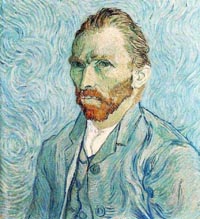  Vincent
Willem van Gogh (30 March 1853 – 29 July 1890)
was a Dutch Post-Impressionist artist. His paintings
and drawings include some of the world's best known,
most popular and most expensive art. Vincent
Willem van Gogh (30 March 1853 – 29 July 1890)
was a Dutch Post-Impressionist artist. His paintings
and drawings include some of the world's best known,
most popular and most expensive art.
Van Gogh spent his early adult life working for
a firm of art dealers. After a spell as a teacher,
he became a missionary worker in a poor mining region.
He embarked on a career as an artist at the age of
37 in 1880.
Van Gogh worked only with sombre colours until he
encountered Impressionism and Neo-Impressionism in
Paris. He incorporated brighter colours and their
style of painting into a unique style, which was fully
developed during the time he spent at Arles. He produced
more than 2,000 works, including around 900 paintings
and 1,100 drawings and sketches, during the last ten
years of his life. Most of his best-known works were
produced in Languedoc and Provence during the final
two years of his life:
Arles (February 1888 – May
1889)
Van Gogh arrived in Arles on the River
Rhône on 21 February 1888 and took quarters
and found lodgings at the Hôtel-Restaurant Carrel,
30 Rue Cavalerie. He had ideas of founding a Utopian
art colony. His companion for two months was the Danish
artist, Christian Mourier-Petersen. In March, he painted
local landscapes, using a gridded "perspective
frame." Three of his pictures were shown at the
annual exhibition of the Société
des Artistes Indépendants. In April he
was visited by the American painter, Dodge MacKnight,
who was resident in Fontvieille nearby.
On 1 May he signed a lease for four rooms in the
right hand side of the "Yellow House" at
No. 2 Place Lamartine. The house was unfurnished and
had been uninhabited for some time so he was not able
to move in straight away. On 7 May he moved out of
the Hôtel Carrel, and into the Café de
la Gare where he became friends with the proprietors,
Joseph and Marie Ginoux. Although the Yellow House
had to be furnished before he could move in, Van Gogh
was able to use it as a studio. His major project
at this time was a series of paintings intended to
form the décoration for the Yellow House.
In June he visited Saintes-Maries-de-la-Mer
in the Camargue.
He gave drawing lessons to Paul-Eugène Milliet,
who also became a companion. MacKnight introduced
him to Eugène Boch, a Belgian painter, who
stayed at times in Fontvieille (they exchanged visits
in July). Gauguin agreed to join him in Arles. In
August he painted sunflowers; Boch visited again.
He finally spent his first night in the Yellow House
on 17 September.
On 23 October his friend Paul
Gauguin arived in in Arles. During November they
painted together. Van Gogh painted some pictures from
memory, deferring to Gauguin as this was not his usual
practice. Their first joint outdoor painting exercise
was conducted at the picturesque Alyscamps. In November
van Gogh painted The Red Vineyard.
In December the two artists visited Montpellier
(in the Hérault
département) and viewed works by Courbet
and Delacroix in the Museé Fabre. However,
their relationship was deteriorating. They quarreled
about art. Van Gogh felt an increasing fear that Gauguin
was going to desert him, and their relationship reached
crisis point on 23 December 1888, when Van Gogh stalked
Gauguin
with a razor and then cut off the lower part of his
own left ear lobe, which he wrapped in newspaper and
gave to a prostitute named Rachel in the local brothel.
Gauguin
left Arles and did not see Van Gogh again.
Van Gogh was hospitalised, apparently in a critical
state for a few days. In January 1889 Van Gogh returned
to the "Yellow House", but spent the following
month between hospital and home, suffering from hallucinations
and paranoia that he was being poisoned. In March
the police closed his house, after a petition by thirty
townspeople, who called him le fou roux ("the
redheaded madman"). Signac visited him in hospital
and Van Gogh was allowed home in his company.
Saint-Rémy (May 1889 –
May 1890)
On 8 May 1889 Van Gogh, accompanied by a carer,
the Reverend Salles, committed himself to the mental
hospital of Saint-Paul-de-Mausole in a former monastery
in Saint Rémy de Provence, a little less than
20 miles (32 km) from Arles. The monastery was a mile
and a half out of the town in an area of cornfields,
vineyards, and olive trees. The hospital was run by
a former naval doctor, Dr. Théophile Peyron.
Theo van Gogh, Vincent's brother, arranged for Vincent
to have two small rooms, one for use as a studio,
although in reality they were adjoining cells with
barred windows.
During his stay there, the clinic and its garden
became his main subject. At this time some of his
work was characterised by swirls, as in one of his
best-known paintings, The Starry Night. He took short
supervised walks, which gave rise to images of cypresses
and olive trees, but because of the shortage of subject
matter due to his limited access to the outside world,
he painted interpretations of Millet's paintings,
as well as his own earlier work. In September 1889
he painted two new versions of the Bedroom in Arles,
and in February 1890 he painted four portraits of
L'Arlésienne (Madame Ginoux), based directly
on a charcoal sketch Paul
Gauguin had produced when Madame Ginoux had sat
for both artists at the beginning of November 1888.
In January 1890, his work was praised by Albert
Aurier in the Mercure de France, and he was called
a genius. In February, invited by Les XX, a society
of avant-garde painters in Brussels, he participated
in their annual exhibition. When, at the opening dinner,
Henry de Groux, a member of Les XX, insulted Van Gogh's
works, Henri
Toulouse-Lautrec demanded satisfaction. Signac
indicated that he was also prepared to defend Van
Gogh's honour, if Toulouse-Lautrec
should lose.
de Groux was in a minority. When Van Gogh's exhibit
was put on display with the Artistes Indépendants
in Paris, Monet said that his work was the best in
the show.
Van Gogh is a pioneer of what came to be known as
Expressionism. He had an enormous influence on 20th
century art, especially on the Fauvists and German
Expressionists.
|
|
|
Vincent
van Gogh.
The Café Terrace on the Place du Forum,
Arles, at Night, September 1888. Oil on Canvass,
81 × 65,5 cm
|
|
|
|
Vincent
van Gogh (1853 - 1890).
La nuit étoilée sur le Rhône
(September 1888) at Arles.
Oil-on-canvas. 72.5 x 92 cm (28.54 x 36.22 inches).
Currently displayed at the Musée d'Orsay,
Paris.
|
|
|
|
Vincent
van Gogh (1853 - 1890).
Bridge at Arles, (1888)
|
|
|
|
Vincent
van Gogh (1853 - 1890).
Cornfield with Cypresses,
|
|
|
|
|
|
Marie Petiet & Etienne Dujardin-Beaumetz
Marie Petiet (1854-1893) was an artist from Limoux
in the Aude
département of the Languedoc-Roussillon
Her work may be found in the Petiet Museum, on the
Promenade du Tivoli, Limoux.
Phone: +33 (0)4 68 31 85 03 - just next to the Tourist
Office. The Petiet Museum was once the workshop of
the Petiet family and has been preserved in such a
way as to keep its 19th Century charm. The collection
is a large one and draws paintings from across Europe.
There are pieces representing almost all of the major
European schools including France, Italy and Holland.
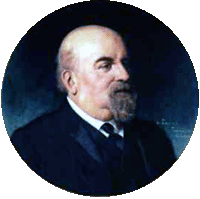  The
Petiet artist siblings donated their collection of
paintings and the building that houses them to the
town of Limoux
in 1880 .Private donations and gifts to the State
make up the rest of the collection, the most recent
dating back to 1962. Canvases on display illustrate
the art of the second half of the 19th century. Firstly
those of the Limoux painters: intimate and sensitive
works by Marie Petiet who drew her inspiration from
everyday town life alongside battle scenes from 1870
war paintings by her husband Etienne Dujardin-Beaumetz.
Painters from the Academy portrayed society as it
appeared at the end of the 19th century. They also
represented the landscapes of that period. Achille
Laugé, another local Aude
artist, depicted typical scenes with splashes of colour
and striking natural light. The
Petiet artist siblings donated their collection of
paintings and the building that houses them to the
town of Limoux
in 1880 .Private donations and gifts to the State
make up the rest of the collection, the most recent
dating back to 1962. Canvases on display illustrate
the art of the second half of the 19th century. Firstly
those of the Limoux painters: intimate and sensitive
works by Marie Petiet who drew her inspiration from
everyday town life alongside battle scenes from 1870
war paintings by her husband Etienne Dujardin-Beaumetz.
Painters from the Academy portrayed society as it
appeared at the end of the 19th century. They also
represented the landscapes of that period. Achille
Laugé, another local Aude
artist, depicted typical scenes with splashes of colour
and striking natural light.
Decorative artefacts, furniture and sculptures have
been added to the museum recreate the atmosphere of
the Belle Epoque |
|
|
Marie
Petiet (1854-1893)
Les Blanchisseuses 1882.
oil on canvas. 1 m 70x 1 m 13
|
|
|
|
Etienne
Dujardin-Beaumetz (1852 1913),
Surrounded
|
|
|
|
|
|
Edouard Debat-Ponsan
Edouard Bernard Debat-Ponsan (1847-1913) was a late
nineteenth century artist treating diverse themes
including Orientalism, landscape, history, religion,
and portrait painting. Trained in the academic
manner, his themes also chronicled changing styles
and preoccupations of his era.
Born on April 25th, 1847 in Toulouse.;
he began his artistic studies at the age of fourteen,
attending the École des Beaux-Arts in Toulouse.
Aware that public artistic careers began at
the École des Beaux-Arts in Paris he moved
there and began studying under Alexandre Cabanel.
Debat-Ponsan first showed at the Salon of 1870, the
year that the Franco-Prussian war broke out, throwing
France into turmoil. At this early period in
his career, Debat-Ponsan treated mythological, historical,
and religious themes, showing his reliance on Ecole
des Beaux-Arts traditions, as did his execution. Tradition
was then being challenged by progressive artists such
as the Impressionists who held their first show in
1874.
Debat-Ponsan worked on establishing himself through
the traditional Salon system, exhibiting under the
name “Ponsan” early in his career, and
then “Debat-Ponsan”, presumably after
another artist by the name of “Ponsan”
entered the scene. Debat-Ponsan was already
beginning to make his mark on the Parisian art world
and to be recognized by those in power.
Debat-Ponsan’s images introduced an element
of personal leisure into bucolic compositions. He
focused on a human presence in his animal paintings
and was interested in depicting peasant life in the
tradition of Jean-François Millet.
In 1882 Debat-Ponsan traveled to Turkey, following
in the footsteps of many other French artists who
left Paris to seek out the exotic Orient as described
by writers and other artists of previous decades.
“Orientalism,” as the tradition of painting
Middle Eastern themes was known, produced many recognizable
images at the Salons. Debat-Ponsan was also an accomplished
portrait painter.
In 1898 he took the liberal stance of supporting
Emile Zola’s position on the Dreyfus affair,
recognizing the validity of Zola’s ideas in
his article, “J’Accuse!”. Debat-Ponsan
found himself on the side of the revolutionaries.
While his individual commissions may have been
affected by his political stances, he continued to
receive official commissions such as those for the
capitol in Toulouse.
and the theater in Nîmes,
from governmental officials of the Third Republic.
After this he retreated to the countryside; working
on compositions based on his journeys in the Languedoc
region in which he was born, executing many landscapes
such as those previously discussed. He continued
to exhibit at the Salon becoming the President of
the Société des Artistes Français
during his career. He died January 29th,
1913 in Paris.
His work can be found in many of the Musées
des Beaux-Arts in France including those in Carcassonne
(Aude),
Dijon, La Rochelle, Nantes, Nîmes,
Pau, Rouen, Toulouse.,
in addition to the Musée d’Orsay in Paris.
|
|
|
Edouard
Bernard Debat-Ponsan (1847-1913)
Gathering Grapes: Languedoc 1886,
O il on canvas
|
|
|
|
Edouard
Bernard Debat-Ponsan (1847-1913)
The Shepherdess, circa 1890
Oil on canvas
h: 22 x w: 18 in / h: 55.9 x w: 45.7 cm
|
|
|
|
|
|
Achille Laugé
Achille Laugé (1861 Arzens (Aude
département) - 1944 Cailhau (Aude
département) was the son of prosperous
farmers who moved to Cailhau near Carcassonne
(Aude),
where he spent most of his life. Laugé began
his studies in Toulouse in 1878 and went to Paris
in 1881. At the Ecole des Beaux-Arts he studied with
Alexandre Cabanel and Jean-Paul
Laurens. There, Antoine Bourdelle, whom Laugé
had known in Toulouse, introduced him to Aristide
Maillol and the three maintained a long and fruitful
friendship.
Laugé’s time in Paris spanned the years
from 1886 to1888 during which he was influenced by
Neo-Impressionism. In 1894 he exhibited at the Salon
des Indépendants, as well as at a Toulouse
exhibition with i
Toulouse-Lautrec and others. He held several one-man
shows in Paris from 1907 to 1930.
In 1888, after seven years in Paris, including a
term of military service, Laugé returned to
the south and established himself at Carcassonne.
Here Laugé developed his divisionist technique,
following the lead of Seurat and the Pointillists.
Although Laugé never adopted Seurat’s
scientific attitude, his interest in the primacy and
division of colour resulted in work with a vivid,
translucent palette. From 1888 until about 1896, Laugé
composed his pictures with small points of colour.
In 1895, he returned to Cailhau where he spent the
rest of his life. At the end of the century he abandoned
the dots and dabs and painted his landscapes, portraits,
and still-lifes with thin, systematic strokes resembling
crosshatching. After 1905 he applied his pigments
more freely, with enlarged strokes and thick impasto
that brought him closer to a traditional impressionist
technique while maintaining his ability to paint the
translucence of southern light that appealed to him
as to so many other artists.
|
|
|
Achille Laugé
(1861–1944)
La route de campagne près de Cailhau,
1908
Oil on canvas
19 ½ x 28 ½ inches
|
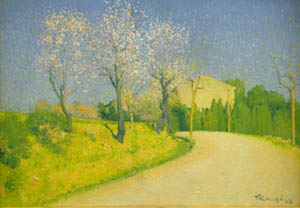 |
|
Achille Laugé
(1861–1944)
The Road To Cailhau Under The Sun, 1910
Oil/canvas
50x70 cm (19.7x27.6 in)
|
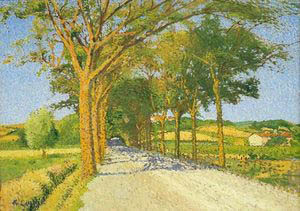 |
|
|
|
Henri Toulouse-Lautrec
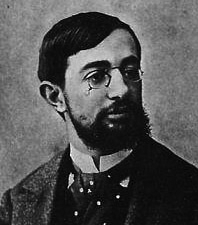  Henri-Marie-Raymond
de Toulouse Lautrec Monfade (1864-1901) was a native
of Albi.
His full name was Henri Marie Raymond de Toulouse-Lautrec
Monfa. He was born on 24th November, 1864, the first
child of Comte Alphonse and Comtesse Adèle
de Toulouse-Lautrec. The Count and Countess were first
cousins, and Henri suffered from congenital health
conditions attributed to this and other family inbreeding.
A younger brother was born on August 28, 1867, but
died the following year. Henri-Marie-Raymond
de Toulouse Lautrec Monfade (1864-1901) was a native
of Albi.
His full name was Henri Marie Raymond de Toulouse-Lautrec
Monfa. He was born on 24th November, 1864, the first
child of Comte Alphonse and Comtesse Adèle
de Toulouse-Lautrec. The Count and Countess were first
cousins, and Henri suffered from congenital health
conditions attributed to this and other family inbreeding.
A younger brother was born on August 28, 1867, but
died the following year.
At the age of 13 Henri fractured his left thigh bone,
and a year later his right one. The breaks did not
heal properly and his legs stopped growing. As an
adult he stood 1.52 m or 5 ft tall, having developed
an adult-sized torso but retaining child-sized legs.
Unable to participate in most of the activities enjoyed
by his peers, Toulouse-Lautrec immersed himself in
art.
His mother took him to Paris where he entered professional
teaching studios in 1882. He settled in Montmartre
in 1884. His immersion in the decadent and theatrical
life of fin de siècle Paris yielded an oeuvre
of provocative images of modern life. His wit attracted
a artists and intellectuals, including Oscar Wilde
and Vincent
van Gogh whom he drew - see right. He studied
with French academic painters L. J. F. Bonnat and
Fernand Cormon. He became an important post-Impressionist
painter, art nouveau illustrator, and lithographer
and recorded in his works many details of the late-19th
century bohemian lifestyle in Paris.
Lautrec met Edgar Degas who provided encouragement
and some of Lautrec’s lithographs reveal his
debt to the older artist. His oeuvre includes paintings,
drawings, etchings, lithographs, and posters, as well
as illustrations for various contemporary newspapers.
He incorporated into his own individual method elements
of the styles of other contemporary artists, especially
Degas and Paul
Gauguin. Japanese art influenced his use of oblique
angles, sharp delineation and flat areas of colour.
His work inspired Vincent
van Gogh, Georges Seurat, and Georges Rouault.
Outstanding examples of his work are La Goulou Entering
the Moulin Rouge (1892, Musée Toulouse-Lautrec,
Albi),
Jane Avril Entering the Moulin Rouge (1892, Courtauld
Gallery, London), and Au salon de la rue des Moulins
(1894, Musée Toulouse-Lautrec, Albi).
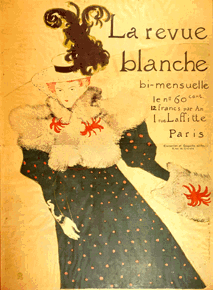  He
was acclaimed as "The soul of Montmartre",
the Parisian quarter where he made his home, frequenting
the circus, the theater, and local brothels. He portrayed
life at the Moulin Rouge and other Montmartre and
Parisian nightspots. He lived in a brothel for long
periods. He painted singer Yvette Guilbert, Louise
Weber (La Goulue) a dancer who created the "French
Can-Can", and the dancer Jane Avril. Toulouse-Lautrec
gave painting lessons to Suzanne Valadon, one of his
models. By the 1890s he had become a leading figure
in the Parisian art world. The largest exhibition
of his work during his lifetime was held at London’s
Goupil Gallery in 1898. He
was acclaimed as "The soul of Montmartre",
the Parisian quarter where he made his home, frequenting
the circus, the theater, and local brothels. He portrayed
life at the Moulin Rouge and other Montmartre and
Parisian nightspots. He lived in a brothel for long
periods. He painted singer Yvette Guilbert, Louise
Weber (La Goulue) a dancer who created the "French
Can-Can", and the dancer Jane Avril. Toulouse-Lautrec
gave painting lessons to Suzanne Valadon, one of his
models. By the 1890s he had become a leading figure
in the Parisian art world. The largest exhibition
of his work during his lifetime was held at London’s
Goupil Gallery in 1898.
An alcoholic for most of his adult life, in the 1890s
he began to drink even more heavily and was placed
in a sanatorium. He died from complications due to
alcoholism and syphilis on 9th September 1901 aged
36, at the family estate in Malromé. He is
buried in Verdelais, in the Gironde, a few kilometres
from his birthplace. He predeceased his father and
so never inherited the family title, derived from
that of the ancient Counts
of Toulouse. (Lautrec is a town not far from Toulouse)
After his death, his mother, the Comtesse Adèle
Toulouse-Lautrec, and his art dealer, Maurice Joyant,
promoted his art. His mother contributed funds for
a museum to be built in Albi
to house his works.
Today he one of the most famous artist in the world.
|
|
|
Henri
Toulouse-Lautrec
(Henri-Marie-Raymond de Toulouse Lautrec Monfa)
(1864-1901):
Vincent van Gogh. (1887)
pastel drawing. 54 × 45 cm .
Currently in the Van Gogh Museum, Amsterdam
|
|
|
|
Henri
Toulouse-Lautrec
(Henri-Marie-Raymond de Toulouse Lautrec Monfa)
(1864-1901):
Jane Avril
|
|
|
|
Henri
Toulouse-Lautrec
(Henri-Marie-Raymond de Toulouse Lautrec Monfa)
(1864-1901):
Divan Japonaise
|
|
|
|
|
|
Charles Rennie Mackintosh
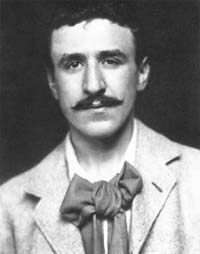  Charles
Rennie Mackintosh was born in Glasgow on June 7, 1868.
At the age of 16 he was apprenticed to an architect
named John Hutchison, where he worked from 1884 until
1889. Also during that time he became a draughtsman
with a new architectural practice, eventually becoming
a partner in 1901. Charles
Rennie Mackintosh was born in Glasgow on June 7, 1868.
At the age of 16 he was apprenticed to an architect
named John Hutchison, where he worked from 1884 until
1889. Also during that time he became a draughtsman
with a new architectural practice, eventually becoming
a partner in 1901.
He lived most of his life in Glasgow. He admired
Japanese style because of how it valued restraint
and economy of means rather than ostentatious accumulation,
simple forms and natural materials rather than elaboration
and artifice, the use of texture and light and shadow
rather than pattern and ornament. In the old western
style furniture was seen as ornament that displayed
the wealth of its owner and the value of the piece
was established according to the length of time spent
creating it. While in the Japanese arts furniture
and design was concerned with the quality of the space
which was meant to evoke a calming and organic feeling
to the interior.
At the same time a new philosophy concerned with
creating functional and practical design was emerging
throughout Europe: the so-called "modernist ideas."
The main concept of the Modernist movement was to
develop innovative ideas and new technology: design
concerned with present and future, rather than history
and tradition. Even though Mackintosh became known
as the ‘pioneer’ of the movement, his
designs are far removed from the bleak and utilitarianism
of modernism… His concern was to build around
the needs of people, people seen not as masses but
as individuals who needed not a machine for living
in but a work of art.
All along he attended evening classes in art at
the Glasgow School of Art. It was at these classes
that he first met Margaret MacDonald (whom he later
married), her sister Frances MacDonald, and Herbert
MacNair who was also a fellow apprentice with Mackintosh
at Honeyman and Keppie. The group of artists, known
as "The Four," exhibited in Glasgow, London
and Vienna, and these exhibitions helped establish
Mackintosh's reputation. The so-called " Glasgow"
style was exhibited in Europe and influenced the Viennese
Art Nouveau movement known as Sezessionstil (in English,
The Secession) around 1900.
Mackintosh’s career was a relatively short
one, but of significant quality and impact. All his
major commissions were between 1896 and 1906, where
he designed private homes, commercial buildings, interior
renovations, church, and furniture. He died on December
10, 1928 of throat cancer.
Mackintosh also worked in interior design, furniture,
textiles and, metalwork. Much of this work combines
Mackintosh's own designs with those of his wife, whose
flowing, floral style complemented his more formal,
rectilinear work. Like his contemporary Frank Lloyd
Wright, Mackintosh's architectural designs often included
extensive specifications for the detailing, decoration,
and furnishing of his buildings. His work was shown
at the Vienna Secession Exhibition in 1900.
Later in life, disillusioned with architecture,
Mackintosh worked largely as a watercolourist, painting
numerous landscapes and flower studies (often in collaboration
with Margaret, with whose style Mackintosh's own gradually
converged) in the Suffolk village of Walberswick (to
which the pair moved in 1914), and where he was arrested
as a possible spy in 1915.
By 1923, he had entirely abandoned architecture
and design and moved to the south of France with Margaret
where he concentrated on watercolour painting. He
was interested in the relationships between man-made
and naturally occurring landscapes. Many of his paintings
depict Port Vendres, a small port near the Spanish
border, and the nearby landscapes.
Mackintosh's designs gained in popularity in the
decades following his death.
|
|
|
Charles
Rennie Mackintosh (1864 - 1933)
The Lighthouse (at Port Vendres) 1927
Watercolour
Private collection, London
|
|
|
|
Charles
Rennie Mackintosh (1864 - 1933)
Bouleternére (1925)
Watercolour (17.6 x 17.6 in. 44.7 x 44.7 cm)
Private colection, New York
|
|
|
|
Charles
Rennie Mackintosh (1864 - 1933)
The Fort, c. 1925-1926.( Fort Mailly, a ruined
16th-century fortification on the outskirts
of Port Vendres).
|
|
|
|
|
|
Henri Matisse.
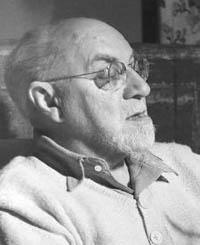  Henri
Matisse (December 31, 1869 – November 3, 1954)
was a French artist, known for his use of colour and
his fluid, brilliant and original draughtsmanship.
As a draughtsman, printmaker, and sculptor, but principally
as a painter, Matisse is one of the best-known artists
of the twentieth century. Although he was initially
labeled as a Fauve (wild beast), by the 1920s, he
was increasingly hailed as an upholder of the classical
tradition in French painting. His mastery of the expressive
language of colour and drawing, displayed in a body
of work spanning over a half-century, won him recognition
as a leading figure in modern art. Henri
Matisse (December 31, 1869 – November 3, 1954)
was a French artist, known for his use of colour and
his fluid, brilliant and original draughtsmanship.
As a draughtsman, printmaker, and sculptor, but principally
as a painter, Matisse is one of the best-known artists
of the twentieth century. Although he was initially
labeled as a Fauve (wild beast), by the 1920s, he
was increasingly hailed as an upholder of the classical
tradition in French painting. His mastery of the expressive
language of colour and drawing, displayed in a body
of work spanning over a half-century, won him recognition
as a leading figure in modern art.
Born Henri-Émile-Benoît Matisse in
Le Cateau-Cambrésis, Nord-Pas-de-Calais, France,
he grew up in Bohain-en-Vermandois in Northeastern
France, where his parents owned a seed business. He
was their first son. In 1887 he went to Paris to study
law, working as a court administrator in Le Cateau-Cambrésis
after gaining his qualification. He first started
to paint in 1889, when his mother had brought him
art supplies during a period of convalescence following
an attack of appendicitis. He discovered "a kind
of paradise" as he later described it, and decided
to become an artist, deeply disappointing his father.
In 1891 he returned to Paris to study art at the Académie
Julian and became a student of William-Adolphe Bouguereau
and Gustave Moreau. Initially he painted still-lifes
and landscapes in the traditional Flemish style, at
which he achieved reasonable proficiency. Chardin
was one of Matisse's most admired painters; as an
art student he made copies of four Chardin paintings
in the Louvre. In 1896 he exhibited 5 paintings in
the salon of the Société Nationale des
Beaux-Arts, and the state bought two of his paintings.
In 1897 and 1898, he visited the painter John Peter
Russell on the island Belle Île off the coast
of Brittany. Russell introduced him to Impressionism
and to the work of Vincent
van Gogh (who had been a good friend of Russell
but was completely unknown at the time).
Influenced by the works of the post-Impressionists
Paul Cézanne, Paul
Gauguin, Vincent
van Gogh and Paul Signac, and also by Japanese
art, he made colour a crucial element of his paintings.
Many of his paintings from 1899 to 1905 make use of
a pointillist technique adopted from Signac. In 1898,
he went to London to study the paintings of J. M.
W. Turner.
His first solo exhibition was in 1904, without much
success. His fondness for bright and expressive colour
became more pronounced after he moved southwards in
1905 to work with André
Derain. The paintings of this period are characterized
by flat shapes and controlled lines, with expression
dominant over detail.
In 1905, Matisse and a group of artists now known
as "Fauves" exhibited work together in a
room at the Salon d'Automne. Critic Louis Vauxcelles
described the work with the phrase "Donatello
au milieu des fauves!" (Donatello among the wild
beasts), referring to a Renaissance-type sculpture
that shared the room with them. His comment was printed
on 17 October 1905 in Gil Blas, a daily newspaper,
and passed into popular usage. The pictures gained
considerable condemnation, but also some favourable
attention. The painting that was singled out for attacks
was Matisse's Woman with a Hat, which was bought by
Gertrude and Leo Stein
Matisse was recognized as a leader of the group,
along with André
Derain; the two were friendly rivals, each with
his own followers. Other members were Georges
Braque, Raoul Dufy and Maurice Vlaminck. The Symbolist
painter Gustave Moreau was the movement's inspirational
teacher, and he did much for the era; a professor
at the École des Beaux-Arts in Paris, he pushed
his students to follow their visions.
His controversial 1907 painting Nu bleu was burned
in effigy at the Armory Show in Chicago in 1913. The
decline of the Fauvist movement, after 1906, did nothing
to affect the rise of Matisse; many of his finest
works were created between 1906 and 1917, when he
was an active part of the great gathering of artistic
talent in Montparnasse, even though he did not quite
fit in, with his conservative appearance and strict
bourgeois work habits.
Like other fauvists Matisse worked in Collioure.
Around 1904 he met Pablo
Picasso, who was 12 years younger than him. The
two became life-long friends as well as rivals and
are often compared; one key difference between them
is that Matisse drew and painted from nature, while
Picasso
was much more inclined to work from imagination. The
subjects painted most frequently by both artists were
women and still lifes, with Matisse more likely to
place his figures in fully realized interiors.
Matisse and Picasso
were first brought together at the Paris salon of
Gertrude Stein and her companion Alice B. Toklas.
In 1917 Matisse relocated to Cimiez on the French
Riviera, a suburb of the city of Nice. His work of
the decade or so following this relocation shows a
relaxation and a softening of his approach. This "return
to order" is characteristic of much art of the
post-World War I period, and can be compared with
the neoclassicism of Pablo
Picasso and Stravinsky, and the return to traditionalism
of André
Derain. His orientalist odalisque paintings are
characteristic of the period; while popular, some
contemporary critics found this work shallow and decorative.
After 1930 a new vigour and bolder simplification
appear in his work.
In 1941 he was diagnosed with cancer and, following
surgery, he started using a wheelchair. With the aid
of assistants he set about creating cut paper collages,
often on a large scale, called gouaches découpés.
His Blue Nudes series feature prime examples of this
technique he called "painting with scissors".
Matisse died of a heart attack at the age of 84
in 1954. He is interred in the cemetery of the Monastère
Notre Dame de Cimiez and a Matisse Museum was opened
in the area.
|
|
|
Henri
Matisse (1869 – 1954).
Les toits de Collioure (1905)
Oil on Canvass. 59.5 x 73 cm
Currently in The Ermitage (State Museum at Saint-Petersbourg)
|
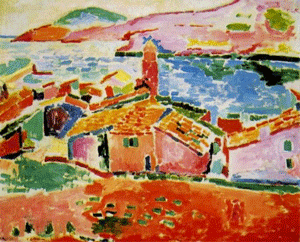 |
|
Henri
Matisse (1869 – 1954).
Sea at Collioure. 1906.
Oil on canvas.
Barnes Foundation, Lincoln University, Merion,
PA, USA.
|
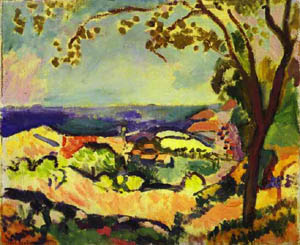 |
|
Henri
Matisse (1869 – 1954).
Landscape at Collioure. (Collioure,
summer 1905).
Oil on canvas.
15 1/4 x 18 3/8" (38.8 x 46.6 cm).
MOMA
|
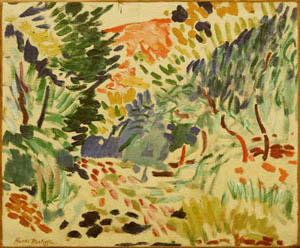 |
|
|
|
Andre Derain
Derain worked in Collioure.
Fauvism was developed in the Languedoc-Roussillon,
Painters having been attracted to the unique light
and scenery
André Derain (June 10, 1880 – September
8, 1954) was a French painter and co-founder of Fauvism
with Henri
Matisse. He was born in 1880 in Chatou, Yvelines,
Île-de-France, just outside Paris.
In 1898, while studying to be an engineer at the
Académie Camillo, he attended painting classes
under Eugène Carrière, where he met
Matisse. In 1900, he met and shared a studio with
Maurice de Vlaminck and began to paint his first landscapes.
His studies were interrupted from 1901 to 1904 when
he was conscripted into the French army. Following
his release from service, Matisse
persuaded Derain's parents to allow him to abandon
his engineering career and devote himself solely to
painting; subsequently Derain attended the Académie
Julian.
Derain and Matisse
worked together through the summer of 1905 in the
Mediterranean village of Collioure,
attracted by the light over the Mediterranean
Sea. Later that year they displayed their innovative
paintings at the Salon d'Automne. The vivid, unnatural
colours led the critic Louis Vauxcelles to derisively
dub their works as les Fauves, or "the wild beasts".
The term was seized upon and provided a name for the
Fauvist movement. In March 1906, the noted art dealer
Ambroise Vollard sent Derain to London to compose
a series of paintings with the city as subject. These
London paintings remain among his most popular work.
Derain experimented with stone sculpture and moved
to Montmartre to be near his friend Pablo
Picasso and other noted artists. At Montmartre,
Derain began to shift from the brilliant Fauvist palette
to more muted tones, showing the influence of Cubism
and Paul Cézanne.
At about this time Derain's work began overtly reflecting
his study of the old masters. The role of colour was
reduced and forms became austere; the years 1911-1914
are sometimes referred to as his gothic period. In
1914 he was mobilized for military service in World
War I and until his release in 1919 had little time
for painting. After the war, Derain won new acclaim
as a leader of the renewed classicism then ascendant.
With the wildness of his Fauve years far behind, he
was admired as an upholder of tradition. In 1919 he
designed the ballet La Boutique fantasque for Diaghilev,
leader of the Ballets Russes. A major success, it
would lead to his creating many ballet designs.
Nazi propaganda made much of Derain's presence in
Germany during the second World War, and after the
Liberation he was branded a collaborator and ostracized
by many former supporters. A year before his death,
he contracted an eye infection from which he never
fully recovered. He died in Garches, Hauts-de-Seine,
Île-de-France, France in 1954 when he was struck
by a vehicle.
|
|
|
Andre
Derain (1880 – 1954).
Bateaux de Collioure (1905)
|
|
|
Andre Derain (1880 –
1954).
Collioure (1905)
Oil on canvas
60.20 x 73.50 cm
|
|
|
|
|
|
Juan Gris
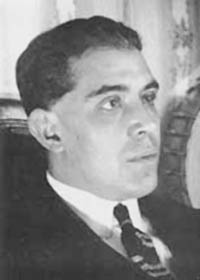  Juan
Gris (originally José Victoriano González-Pérez)
(March 23, 1887 – May 11, 1927) was a Spanish
painter and sculptor who lived and worked in France
most of his life. His works are closely connected
to the emergence of Cubism. Juan
Gris (originally José Victoriano González-Pérez)
(March 23, 1887 – May 11, 1927) was a Spanish
painter and sculptor who lived and worked in France
most of his life. His works are closely connected
to the emergence of Cubism.
Born in Madrid, Gris studied mechanical drawing
at the Escuela de Artes y Manufacturas in Madrid from
1902 to 1904, during which time he contributed drawings
to local periodicals. From 1904 to 1905 he studied
painting with the academic artist José Maria
Carbonero.
In 1906 he moved to Paris and became friends with
Henri
Matisse, Georges
Braque, Fernand Léger, and in 1915 was
painted by his friend, Amedeo Modigliani. In Paris,
Gris followed the lead of another friend and fellow
countryman, Pablo
Picasso. His portrait of Picasso (below) in 1912
is a significant early Cubist painting done by a painter
other than Picasso or Braque. Like Picasso and Braque,
he also painted in Céret.
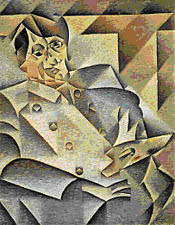  Gris
began to paint seriously in 1910. By 1912 he had developed
a personal Cubist style. After 1913 he began his conversion
to synthetic Cubism, of which he became a steadfast
interpreter, with extensive use of papier collé.
Unlike Picasso and Braque, Gris painted with bright
harmonious colors in daring, novel combinations in
the manner of Matisse. Gris
began to paint seriously in 1910. By 1912 he had developed
a personal Cubist style. After 1913 he began his conversion
to synthetic Cubism, of which he became a steadfast
interpreter, with extensive use of papier collé.
Unlike Picasso and Braque, Gris painted with bright
harmonious colors in daring, novel combinations in
the manner of Matisse.
He died in Boulogne-sur-Seine ( Paris) in the spring
of 1927 at the age of forty.
|
|
Juan Gris (1887 - 1927)
Landscape at Ceret, 1913;
Oil on canvas,
92 x 60 cm (36 1/4 x 23 5/8 in);
Moderna Museet, Stockholm |
|
|
|
|
|
Sir William Russell Flint (1880 - 1969)
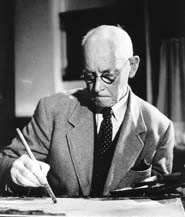  Born
in Edinburgh, 4th April 1880, Flint's talent was discovered
at an early age. Having been a student at the
Royal Institution School of Art in Edinburgh, and
serving a six year apprenticeship at a large printing
works, he moved to London to become a medical illustrator
at the age of 20. Born
in Edinburgh, 4th April 1880, Flint's talent was discovered
at an early age. Having been a student at the
Royal Institution School of Art in Edinburgh, and
serving a six year apprenticeship at a large printing
works, he moved to London to become a medical illustrator
at the age of 20.
In 1903 he joined the Illustrated London News which
sent him to the far reaches of the British Empire.
He became a freelance artist in 1907 which lead him
to illustrate a number of classical limited editions
such as Mallory's 'Morte D'Arthur', Chaucer's 'Canterbury
Tales' and Homer's 'Odyssey'.
He served in the First World War and became Admiralty
Assistant Overseer - Airships. This took him back
to his native Scotland, where in 1919 he painted a
tiny watercolour called "Hilda's Bonnet"
on the linen of a fragment of HM Airship 24 which
he had previously commanded.
After the Great War, William Russell Flint's artistic
career began to flourish. He painted in the Languedoc-Roussillon
and Spain (until the Civil War), where he produced
wonderful paintings reflecting the local scenery and
culture.
He was elected Associate of the Royal Academy in
1924, full member in 1933 and in 1936 became President
of the Royal Society of Painters in Watercolour. After
living in Devon during the Second World War, he and
his wife moved back to London where the post war period
became Russell Flint's greatest.
His talent with both the watercolour medium and
his skill in depicting the female form created a hallmark
style.
In 1947 William Russell Flint was knighted. In 1962
his work was acknowledged by a retrospective exhibition
in the Diploma Gallery of the Royal Academy. In December
1969, Sir William Russell Flint died, aged 89.
|
|
|
Sir
William Russell Flint (1880 - 1969)
Gypsies And Goats Languedoc
Watercolour
|
|
|
|
Sir
William Russell Flint (1880 - 1969)
The Farmyard At Argilliers Languedoc
Watercolour
|
|
|
|
|
|
Pablo Picasso
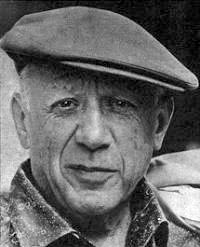  Pablo
Diego José Francisco de Paula Juan Nepomuceno
María de los Remedios Cipriano de la Santísima
Trinidad Clito, was named after various saints and
relatives along with Ruiz and Picasso, after his father
and mother, according to Spanish custom. He was born
in the city of Málaga in the Andalusian region
of Spain. His family was middle-class, his father
being a painter whose specialised in naturalistic
depictions of birds and other game. Pablo
Diego José Francisco de Paula Juan Nepomuceno
María de los Remedios Cipriano de la Santísima
Trinidad Clito, was named after various saints and
relatives along with Ruiz and Picasso, after his father
and mother, according to Spanish custom. He was born
in the city of Málaga in the Andalusian region
of Spain. His family was middle-class, his father
being a painter whose specialised in naturalistic
depictions of birds and other game.
Picasso showed a passion and a skill for drawing
from an early age. From the age of seven, Picasso
received formal artistic training from his father
in figure drawing and oil painting. Ruiz was a traditional,
academic artist and instructor who believed that proper
training required disciplined copying of the masters,
and drawing the human body from plaster casts and
live models. His son became preoccupied with art to
the detriment of his classwork.
The family moved to La Coruña in 1891 so
his father could become a professor at the School
of Fine Arts. They stayed almost four years. On one
occasion the father found his son painting over his
unfinished sketch of a pigeon. Observing the precision
of his son’s technique, Ruiz felt that the thirteen-year-old
Picasso had surpassed him, and vowed to give up painting.
After the death of his sister in 1895, the family
moved to Barcelona, with Ruiz transferring to its
School of Fine Arts. Picasso thrived in the city,
regarding it in times of sadness or nostalgia as his
home. Ruiz persuaded the officials at the academy
to allow his son to take an entrance exam for the
advanced class. This process often took students a
month, but Picasso completed it in a week, and the
impressed jury admitted Picasso, who was still 13.
Picasso’s father and uncle decided to send
the young artist to Madrid’s Royal Academy of
San Fernando, the foremost art school in the country.
In 1897, Picasso, age 16, set off for the first time
on his own. Yet his difficulties accepting formal
instruction led him to stop attending class soon after
enrolment. Madrid, however, held many other attractions:
the Prado housed paintings by the venerable Diego
Velázquez, Francisco Goya, and Francisco Zurbarán.
Picasso especially admired the works of El Greco;
their elements, like elongated limbs, arresting colours,
and mystical visages, are echoed in Picasso’s
œuvre.
Picasso remained neutral during World War I, the
Spanish Civil War, and World War II, refusing to fight
for any side or country. Some of his contemporaries
felt that his pacifism had more to do with cowardice
than principle. As a Spanish citizen living in France,
Picasso was under no compulsion to fight against the
invading Germans in either World War. In the Spanish
Civil War, service for Spaniards living abroad was
optional and would have involved a voluntary return
to the country to join either side. While Picasso
expressed anger and condemnation of Francisco Franco
and fascists through his art, he did not take up arms
against them. He also remained aloof from the Catalan
independence movement during his youth despite expressing
general support and being friendly with activists
within it.
Picasso had constructed a huge gothic structure
and could afford large villas in the south of France,
at Notre-dame-de-vie on the outskirts of Mougins,
in the Provence-Alpes-Côte d'Azur.
Picasso’s work is often categorized into periods.
While the names of many of his later periods are debated,
the most commonly accepted periods in his work are
the Blue Period (1901–1904), the Rose Period
(1905–1907), the African-influenced Period (1908–1909),
Analytic Cubism (1909–1912), and Synthetic Cubism
(1912–1919).
Picasso’s training under his father began
before 1890. His progress can be traced in the collection
of early works now held by the Museu Picasso in Barcelona,
which provides one of the most comprehensive records
extant of any major artist’s beginnings. During
1893 the juvenile quality of his earliest work falls
away, and by 1894 his career as a painter can be said
to have begun. The academic realism apparent in the
works of the mid-1890s is well displayed in The First
Communion (1896), a large composition that depicts
his sister, Lola. In the same year, at the age of
14, he painted Portrait of Aunt Pepa, a vigorous and
dramatic portrait that Juan-Eduardo Cirlot has called
“without a doubt one of the greatest in the
whole history of Spanish painting.”
In 1897 his realism became tinged with Symbolist
influence, in a series of landscape paintings rendered
in non naturalistic violet and green tones. What some
call his Modernist period (1899–1900) followed.
His exposure to the work of Rossetti, Steinlen, Toulouse-Lautrec
and Edvard Munch, combined with his admiration for
favourite old masters such as El Greco, led Picasso
to a personal version of modernism in his works of
this period.
Picasso’s Blue Period (1901–1904) consists
of sombre paintings rendered in shades of blue and
blue-green, only occasionally warmed by other colours.
This period’s starting point is uncertain; it
may have begun in Spain in the spring of 1901, or
in Paris in the second half of the year. Many paintings
of gaunt mothers with children date from this period.
In his austere use of colour and sometimes doleful
subject matter—prostitutes and beggars are frequent
subjects—Picasso was influenced by a trip through
Spain and by the suicide of his friend Carlos Casagemas.
Starting in autumn of 1901 he painted several posthumous
portraits of Casagemas, culminating in the gloomy
allegorical painting La Vie (1903), now in the Cleveland
Museum of Art. Blindness is a recurrent theme in Picasso’s
works of this period, also represented in The Blindman’s
Meal (1903, the Metropolitan Museum of Art) and in
the portrait of Celestina (1903).
The Rose Period (1904–1906) is characterized
by a more cheery style with orange and pink colours,
and featuring many acrobats and harlequins. The harlequin,
a comedic character usually depicted in chequered
patterned clothing, became a personal symbol for Picasso.
Picasso’s African-influenced Period (1907–1909)
begins with the two figures on the right in his painting,
Les Demoiselles d'Avignon, which were inspired by
African artefacts. Formal ideas developed during this
period lead directly into the Cubist period that follows.
Analytic cubism (1909–1912) is a style of
painting Picasso developed along with Georges
Braque using monochrome brownish and neutral colours.
Both artists took apart objects and “analyzed”
them in terms of their shapes. Picasso and Braque’s
paintings at this time have many similarities.
Cubism developed in the crucial years from 1907
to 1914 and is widely regarded as the most innovative
and influential artistic style of the 20th century.
During the summer of 1911, Georges
Braque and Pablo Picasso painted side by side
in Céret,
in the Roussillon, each artist producing paintings
that are difficult to distinguish from those of the
other.
At its climax, Braque
and Picasso brought Analytic Cubism almost to the
point of complete abstraction. Among such works is
Picasso’s Accordionist, a baffling composition
that one of its former owners mistook for a landscape
because of the inscription “Céret”
on the reverse. With diligence, one can distinguish
the general outlines of the seated accordionist, denoted
by a series of shifting vertically aligned triangular
planes, semicircular shapes, and right angles; the
centrally located folds of the accordion and its keys;
and, in the lower portion of the canvas, the volutes
of an armchair.
In Landscape at Céret,
another canvas painted that summer, patches of muted
earthy colour, schematised stairways, and arched window
configurations exist as visual clues that must be
pieced together.
Man with Guitar was p ainted during Picasso’s
third summer in Céret,
the painting again has its foundation in the geometry,
stemming from the Sardana’s rhythm. Picasso
positioned rectangles to form the man’s body
and the neck of the guitar. Crescents and ovals form
the man’s face, hat brim, and the guitar’s
body. As seen in his first Man with Guitar,
Picasso built off this structure by disregarding boundaries
for the objects, paralleling the continual improvisation
in the Sardana The man and the guitar blend into each
other, perhaps Picasso’s illustration of music’s
ability to capture and influence a person –
just as the Catalan music did to Picasso.
Synthetic cubism (1912–1919) was a further
development of the genre, in which cut paper fragments—often
wallpaper or portions of newspaper pages—were
pasted into compositions, marking the first use of
collage in fine art.
In the period following the upheaval of World War
I, Picasso produced work in a neoclassical style.
This “return to order” is evident in the
work of many European artists in the 1920s, including
André
Derain, Giorgio de Chirico, and the artists of
the New Objectivity movement. Picasso’s paintings
and drawings from this period frequently recall the
work of Ingres. During the 1930s, the minotaur replaced
the harlequin as a common motif in his work. His use
of the minotaur came partly from his contact with
the surrealists, who often used it as their symbol,
and it appears in Picasso’s Guernica.
Picasso was one of 250 sculptors who exhibited in
the 3rd Sculpture International held at the Philadelphia
Museum of Art in the summer of 1949. In the 1950s,
Picasso’s style changed once again, as he took
to producing reinterpretations of the art of the great
masters. He made a series of works based on Velazquez’s
painting of Las Meninas. He also based paintings on
works by Goya, Poussin, Manet, Courbet and Delacroix.
He was commissioned to make a maquette for a huge
50-foot (15 m)-high public sculpture to be built in
Chicago, known usually as the Chicago Picasso. He
approached the project with a great deal of enthusiasm,
designing a sculpture which was ambiguous and somewhat
controversial. What the figure represents is not known;
it could be a bird, a horse, a woman or a totally
abstract shape. The sculpture, one of the most recognizable
landmarks in downtown Chicago, was unveiled in 1967.
Picasso refused to be paid $100,000 for it, donating
it to the people of the city.
Picasso’s final works were a mixture of styles,
his means of expression in constant flux until the
end of his life. Devoting his full energies to his
work, Picasso became more daring, his works more colourful
and expressive, and from 1968 to 1971 he produced
a torrent of paintings and hundreds of copperplate
etchings. At the time these works were dismissed by
most as pornographic fantasies of an impotent old
man or the slapdash works of an artist who was past
his prime. Only later, after Picasso’s death,
when the rest of the art world had moved on from abstract
expressionism, did the critical community come to
see that Picasso had invented neo-expressionism.
Pablo Picasso died on April 8, 1973 in Mougins,
France, while he and his wife Jacqueline entertained
friends for dinner. His final words were “Drink
to me, drink to my health, you know I can’t
drink any more.” He was interred at Castle Vauvenargues’
park, in Vauvenargues, Bouches-du-Rhône.
|
|
|
Pablo
Picasso (1881 – 1973).
Les Demoiselles d'Avignon, 1907.
The Museum of Modern Art, New York.
|
|
|
|
Pablo Picasso
(1881 – 1973).
Landscape at Céret (Paysage de Céret),
Céret, Summer 1911.
Oil on canvas,
25 5/8 x 19 3/4 inches.
Guggenheim Museum
|
|
|
|
Pablo Picasso
(1881 – 1973).
Man with Guitar 1913
MOMAt, NY
|
|
|
|
|
|
Georges Braque
Georges Braque (May 13, 1882 – August 31, 1963)
was a major 20th century French painter and sculptor
who, along with Pablo
Picasso, developed the art movement known as cubism.
Georges Braque was born in Argenteuil-sur-Seine,
France. He grew up in Le Havre and trained to be a
house painter and decorator as his father and grandfather
were, but he also studied painting in the evenings
at the École des Beaux-Arts in Le Havre from
about 1897 to 1899. He apprenticed in Paris under
a decorator and was awarded his certificate in 1902.
The following year he attended the Académie
Humbert, also in Paris, and painted there until 1904.
His earliest works were impressionistic, but after
seeing the work exhibited by the Fauves in 1905 Braque
adopted a Fauvist style. The Fauves, a group that
included Henri
Matisse and André
Derain among others, used brilliant colours and
loose structures of forms to capture the most intense
emotional response. Braque worked most closely with
the artists Raoul Dufy and Othon Friesz, who shared
Braque's hometown of Le Havre, to develop a somewhat
more subdued Fauvist style. In 1906, Braque traveled
with Friesz to L'Estaque, to Antwerp, and home to
Le Havre to paint.
In May 1907, Braque successfully exhibited works
in the Fauve style in the Salon des Indépendants.
The same year, Braque's style began a slow evolution
as he came under the strong influence of Paul Cézanne,
who died in 1906, and whose works were exhibited in
Paris for the first time in a large scale museum-like
retrospective in September 1907. The 1907 Cezanne
retrospective at the Salon d'Automne greatly impacted
the direction that the avant-garde in Paris took,
leading to the advent of Cubism.
Braque's paintings of 1908–1913 began to reflect
his new interest in geometry and simultaneous perspective.
He conducted an intense study of the effects of light
and perspective and the technical means that painters
use to represent these effects, appearing to question
the most standard of artistic conventions. In his
village scenes, for example, Braque frequently reduced
an architectural structure to a geometric form approximating
a cube, yet rendered its shading so that it looked
both flat and three-dimensional. In this way Braque
called attention to the very nature of visual illusion
and artistic representation.
Beginning in 1909, Braque began to work closely
with Pablo
Picasso who had been developing a similar approach
to painting. The invention of Cubism was a joint effort
between
Picasso and Braque, working in Montmartre, Paris
and in Collioure
in the Roussillon. These artists were the movement's
main innovators. After meeting in 1907 Braque and
Picasso in particular began working on the development
of Cubism in 1908. Both artists produced paintings
of neutralized colour and complex patterns of faceted
form, now called Analytic Cubism. In 1912, they began
to experiment with collage and papier collé.
Their productive collaboration continued and they
worked closely together until the outbreak of World
War I in 1914 when Braque enlisted in the French Army,
leaving Paris to fight in the First World War.
French art critic Louis Vauxcelles first used the
term Cubism, or "bizarre cubiques", in 1908
after seeing a picture by Braque. He described it
as 'full of little cubes', after which the term quickly
gained wide use although the two creators did not
initially adopt it. Art historian Ernst Gombrich described
cubism as "the most radical attempt to stamp
out ambiguity and to enforce one reading of the picture
- that of a man-made construction, a coloured canvas."
The Cubist movement spread quickly throughout Paris
and Europe.
Braque was severely wounded in the war, and when
he resumed his artistic career in 1917 he moved away
from the harsher abstraction of cubism. Working alone,
he developed a more personal style, characterized
by brilliant colour and textured surfaces and—following
his move to the Normandy seacoast—the reappearance
of the human figure. He painted many still life subjects
during this time, maintaining his emphasis on structure.
During his recovery he became a close friend of the
cubist artist Juan Gris.
He continued to work throughout the remainder of
his life, producing a considerable number of distinguished
paintings, graphics, and sculptures, all imbued with
a pervasive contemplative quality. He died August
31, 1963, in Paris.
|
|
|
Georges
Braque. (1882-1963).
Man with a Guitar. Céret, summer 1911-early
1912.
Oil on canvas, 45 3/4 x 31 7/8" (116.2
x 80.9 cm).
|
|
|
|
|
|
Marc Chagall
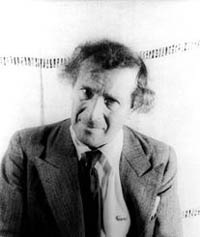  Marc
Chagall was a Belarusian-French painter of Belarusian-Jewish
origin who was born in Belarus, at that time part
of the Russian Empire. He is associated with the modern
movements after impressionism. Marc
Chagall was a Belarusian-French painter of Belarusian-Jewish
origin who was born in Belarus, at that time part
of the Russian Empire. He is associated with the modern
movements after impressionism.
Chagall took inspiration from Belarusian folk-life,
and portrayed many Old Testament themes that reflected
his Jewish heritage.
Chagall lived and worked in Céret
in the Pyrénées-Orientales
département of the Languedoc-Roussillon.
Pablo
Picasso and Georges
Braque developed Cubism both here and on the other
side of the Pyrennes.
In the 1960s and 1970s, Chagall engaged in a series
of large-scale projects involving public spaces and
important civic and religious buildings.
Chagall's artworks are difficult to categorize. Working
in the pre-World War I Paris art world, he was involved
with avant-garde currents, however, his work was consistently
on the fringes of popular art movements and emerging
trends, including Cubism and Fauvism, among others.
He was closely associated with the Paris School and
its exponents, including Amedeo Modigliani.
Abounding with references to his childhood, Chagall's
work has also been criticized for slighting some of
the turmoil which he experienced. He communicates
happiness and optimism to those who view his work
strictly in terms of his use of highly vivid colours.
Chagall often posed himself, sometimes together with
his wife, as an observer of a coloured world like
that seen through a stained-glass window. Some see
The White Crucifixion, which is rich with intriguing
detail, as a denunciation of the Stalin regime, the
Nazi Holocaust, and the oppression of Jews.
|
|
|
Marc
Chagall.
La Baie Des Anges.
Lithograph 10.75 x 12.75 inches
|
|
|
|
|
|
René Magritte
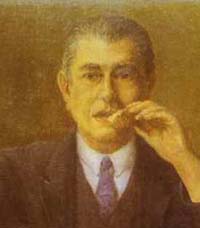  René
François Ghislain Magritte (November 21, 1898
– August 15, 1967) was a Belgian surrealist
artist. He became well known for a number of witty
and amusing images. René
François Ghislain Magritte (November 21, 1898
– August 15, 1967) was a Belgian surrealist
artist. He became well known for a number of witty
and amusing images.
Magritte was born in Lessines, in the province of
Hainaut, in 1898, the eldest son of Léopold
Magritte, a tailor, and Adeline, a milliner. He began
drawing lessons in 1910. In 1912, his mother committed
suicide by drowning herself in the River Sambre. Magritte
was present when her body was retrieved from the water.
The image of his mother floating, her dress obscuring
her face, may have influenced a 1927-1928 series of
paintings of people with cloth obscuring their faces,
including Les Amants, but Magritte disliked this explanation.
He studied at the Académie Royale des Beaux-Arts
in Brussels for two years until 1918. In 1922 he married
Georgette Berger, whom he had met in 1913.
Magritte worked in a wallpaper factory, and was
a poster and advertisement designer until 1926 when
a contract with Galerie la Centaure in Brussels made
it possible for him to paint full-time. In 1926, Magritte
produced his first surreal painting, The Lost Jockey
(Le jockey perdu), and held his first exhibition in
Brussels in 1927. Critics heaped abuse on the exhibition.
Depressed by the failure, he moved to Paris where
he became friends with André Breton, and became
involved in the surrealist group. When Galerie la
Centaure closed and the contract income ended, he
returned to Brussels and worked in advertising. Then,
with his brother, he formed an agency, which earned
him a living wage.
Surrealist patron Edward James allowed Magritte,
in the early stages of his career, to stay rent-free
in his London home and paint. James features in two
of Magritte’s pieces, The Principle Pleasure
and La Reproduction Interdite. In 2005 he came ninth
in the Walloon version of De Grootste Belg (The Greatest
Belgian); in the Flemish version he was 18th.
A consummate technician, his work frequently displays
a juxtaposition of ordinary objects in an unusual
context, giving new meanings to familiar things. The
representational use of objects as other than what
they seem is typified in his painting, The Treachery
of Images (La trahison des images), which shows a
pipe that looks as though it is a model for a tobacco
store advertisement. Magritte painted below the pipe,
This is not a pipe (Ceci n'est pas une pipe), which
seems a contradiction, but is actually true: the painting
is not a pipe, it is an image of a pipe. (In his book,
This Is Not a Pipe, French philosopher and critic
Michel Foucault discusses the painting and its paradox.)
Magritte pulled the same stunt in a painting of
an apple: he painted the fruit realistically and then
used an internal caption or framing device to deny
that the item was an apple. In these Ceci n'est pas
works, Magritte points out that no matter how closely,
through realism-art, we come to depicting an item
accurately, we never do catch the item itself: we
cannot smoke tobacco with a picture of a pipe.
His art shows a more representational style of surrealism
compared to the "automatic" style seen in
works by artists like Joan Miró. In addition
to fantastic elements, his work is often witty and
amusing. He also created a number of surrealist versions
of other famous paintings.
|
|
|
Rene
Magritte (1898 - 1967).
Le Château des Pyrénées
(1959)
|
|
|
|
|
|
Salvador Dali
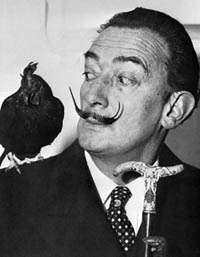  Salvador
Domingo Felipe Jacinto Dalí i Domènech,
1st Marquis of Púbol (May 11, 1904 –
January 23, 1989), was a Spanish surrealist painter
born in Figueres, Catalonia, Spain. Salvador
Domingo Felipe Jacinto Dalí i Domènech,
1st Marquis of Púbol (May 11, 1904 –
January 23, 1989), was a Spanish surrealist painter
born in Figueres, Catalonia, Spain.
Dalí was a skilled draftsman, best known
for the striking and bizarre images in his surrealist
work. His painterly skills are often attributed to
the influence of Renaissance masters.
Dalí insisted on his "Arab lineage",
claiming that his ancestors were descended from the
Moors who occupied Southern Spain for nearly 800 years
(711-1492).
Widely considered to be greatly imaginative, Dalí
had an affinity for doing unusual things to draw attention
to himself. His eccentric manner sometimes drew more
public attention than his artwork. The purposefully-sought
notoriety led to broad public recognition.
Salvador Domingo Felipe Jacinto Dalí i Domènech,
was born on May 11, 1904, in the town of Figueres,
in the Empordà region close to the French border
in Catalonia, Spain.
When he was five, Dalí was taken to his brother's
grave and told by his parents that he was his brother's
reincarnation which he came to believe.
Dalí attended drawing school. In 1916 Dalí
also discovered modern painting on a summer vacation
to Cadaqués with the family of Ramon Pichot,
a local artist who made regular trips to Paris. The
next year, Dalí's father organized an exhibition
of his charcoal drawings in their family home. He
had his first public exhibition at the Municipal Theater
in Figueres in 1919.
In Madrid he studied at the Academia de San Fernando
( School of Fine Arts). He experimented with Cubism,
earning him attention from his fellow students. In
these earliest Cubist works, he probably did not completely
understand the movement, since his only information
on Cubist art came from a few magazine articles and
a catalogue given to him by Pichot, and there were
no Cubist artists in Madrid at the time.
Dalí also experimented with Dada, which influenced
his work throughout his life. At the Residencia, he
became close friends with, among others, Pepín
Bello, Luis Buñuel, and the poet Federico García
Lorca.
Dalí was expelled from the Academia in 1926
shortly before his final exams when he stated that
no one on the faculty was competent enough to examine
him. In 1926 he made his first visit to Paris where
he met Pablo
Picasso. Picasso had already heard favourable
things about Dalí from Joan Miró. Dalí
did a number of works heavily influenced by Picasso
and Miró over the next few years as he developed
his own style.
Trends in Dalí's work that would continue
throughout his life were already evident in the 1920s.
Dalí devoured influences from many styles of
art and then produced works ranging from the most
academically classic, evidencing a familiarity with
Raphael, Bronzino, Francisco de Zurbaran, Vermeer,
and Velázquez, to the most cutting-edge avant-garde,
sometimes in separate works and sometimes combined.
Exhibitions of his works in Barcelona attracted much
attention and mixtures of praise and puzzled debate
from critics. Dalí grew a flamboyant moustache,
influenced by that of seventeenth century Spanish
master painter Diego Velázquez.
Dali, instead of condemning Hitler as his fellow
surrealists, developed an obsessive interest in what
he called "the Hitler phenomenon" which
was frowned upon by his predominantly Marxist surrealist
colleagues. Then, when Francisco Franco came to power
in the aftermath of the Spanish Civil War, Dalí
was one of the few Spanish intellectuals supportive
of the new regime which eventually resulted in his
official expulsion from the surrealist group. The
surrealists henceforth spoke of Dalí in the
past tense, as if he was dead.
In 1940, Dalí and Gala moved to the United
States, where they lived for eight years. An Italian
friar, Gabriele Maria Berardi, claimed to have performed
an exorcism on Dalí while he was in France
in 1947. The friar's estate contained a sculpture
of Christ on the cross which Dalí had given
his exorcist to thank him.
Starting in 1949, Dalí spent his remaining
years back in his beloved Catalonia. The fact that
he chose to live in Spain while it was ruled by Franco
drew criticism from progressives and many other artists.
As such, it is probable that at least some of the
common dismissal of Dalí's later works had
more to do with politics than the actual merits of
the works themselves.
Dalí’s post-World War II period bore
the hallmarks of technical virtuosity and an interest
in optical illusions, science and religion. Increasingly
Catholic, and inspired by the shock of Hiroshima,
he labeled this period "Nuclear Mysticism".
In paintings such as The Madonna of Port-Lligat (first
version) of 1949 and Corpus Hypercubus, 1954, Dalí
sought to synthesize Christian iconography with images
of material disintegration inspired by nuclear physics.
“Nuclear Mysticism” included such notable
pieces as La Gare de Perpignan, 1965, Dali famously
asserted that the Railway Station at Perpignan,
capital of the Pyrénées-Orientales
département was the centre of the universe.
In 1960, Dalí began work on the Dalí
Theatre and Museum in his home town of Figueres; it
was his largest single project and the main focus
of his energy through 1974. He continued to make additions
through the mid-1980s.
In 1980, Dalí's health took a catastrophic
turn. His near-senile wife Gala was dosing him with
a dangerous cocktail of non-prescribed medicine that
damaged his nervous system, thus causing an untimely
end to his artistic ability. At 76 years old, the
'ever-healthy' Dalí was a complete wreck, his
right hand trembling terribly, Parkinson-like.
In 1982, King Juan Carlos of Spain bestowed on Dalí
the title Marquis of Pubol, for which Dalí
later paid him by giving him a drawing (Head of Europa,
which would turn out to be Dalí's final drawing)
after the king visited him on his deathbed.
Gala died on June 10, 1982. After Gala's death,
Dalí lost much of his will to live. He deliberately
dehydrated himself—possibly as a suicide attempt,
possibly in an attempt to put himself into a state
of suspended animation, as he had read that some microorganisms
could do. He moved from Figueres to the castle in
Púbol which he had bought for Gala and was
the site of her death. In 1984, a fire broke out in
his bedroom. In any case, Dalí was rescued
and returned to Figueres where a group of his friends,
patrons, and fellow artists saw to it that he was
comfortable living in his Theater-Museum for his final
years.
In November 1988 Dali entered the hospital with
heart failure and on December 5, 1988 was visited
by King Juan Carlos. On January 23, 1989 he died of
heart failure at Figueres.
|
|
|
Salvador
Dali (1904 – 1989)
Llaner Beach in Cadaques.
An early work c. 1921.
Oil on cardboard.
Private collection.
|
|
|
|
Salvador
Dali (1904 – 1989)
Galatea of the Spheres (Galatee aux Spheres)
1952
Oil on canvas 65 x 54 cm
Fundacion Gala-Salvador-Dali, Figueras, Spain.
|
|
|
Salvador Dali (1904 –
1989)
Crucifixion or Corpus Hypercubicus (1954)
Oil on canvas.
194.5 x 124 cm.
The Metropolitan Museum of Art, New York, USA.
. |
|
|
|
Salvador
Dali (1904 – 1989)
Self Portrait as Mona Lisa. 1954
Photographic elements by Philippe Halsman
from: Marcel Duchamp [the catalogue of an exhibition
at the Museum of Modern Art and the Philadelphia
Museum of Art] 1973, p. 195.
|
|
|
|
Salvador
Dali (1904 – 1989)
The Railway Station at Perpignan. 1965.
Oil on canvas.
295 x 406 cm.
Museum Ludwig, Cologne, USA.
|
|
|
|
|
|
Yves Brayer
  Yves
Brayer (Versailles 1907 - Paris 1990) was a
painter of genre scenes, animals,
landscapes with figures, seascapes, mural compositions,
settings and costumes for plays, gouaches, watercolours,
etcher, engraver, lithographer, illustrator. Yves
Brayer (Versailles 1907 - Paris 1990) was a
painter of genre scenes, animals,
landscapes with figures, seascapes, mural compositions,
settings and costumes for plays, gouaches, watercolours,
etcher, engraver, lithographer, illustrator.
Yves Brayer was born in 1907 in
Versailles, but was brought up in Bourges. Arriving
in Paris in 1924, he attended art academies in Montparnasse
and studied later at the Fine Arts School of Paris.
A scholarship granted by the French
government enabled him in 1927 to travel to Spain;
he studied old masters in the Prado Museum who were
to have an influence on his future works. After a
stay in Morocco, he was awarded the “Grand Prix
de Rome” in 1930. Back in Paris in 1934, he
showed his works at an important exhibition organised
by the Gallery Charpentier.
He stayed in Paris and opened his
own workshop in the “Quartier Latin”.
In 1940, he moved to Cordes-sur-Ciel
where later, in 1960, the city hall would open a museum
in his honour. He returned to Paris in 1942 and created
costumes and settings for a ballet in the Parisian
Opera House. Being in Paris during the Occupation
by the German Army, he was on hand to paint the liberation
of the city.
The year 1945 showed a new development
of his style: having discovered the landscapes of
Provence, he became copnscious of untouched and savage
nature; he became fascinated by the Alpilles Mountains
near Le Destet and the flat countryside of the Camargue
with its famous white Camargue
horses and black Camargue bulls.
Yves Brayer was among those painters
who, after World War II, rejected the pictorial movements
of the last 19th and the beginning 20th centuries,
feeling closer to Vuillard and Bonnard (the group
“Réalité Poétique”)
or admiring Courbet (movement “Forces Nouvelles”).
Brayer was a friend of Francis Gruber who originated
the “Nouveau Réalisme Français”
during the fifties.
After the period in Spain dominated
by dark colours, and the period in Italy when he preferred
red and ochre, he now diversified introducing green,
blue and yellow paints. Attracted by Mediterranean
landscapes, he returned to Spain and Italy, but
Provence and the Camargue
were to remain his favourites. He
also travelled to Mexico, Egypt, Iran, Greece, Russia,
the United States and Japan where he created numerous
sketches and watercolours.
He made copper engravings and lithographs
and illustrated books written by Cendrars, de Montherlant,
Baudelaire, Claudel, Giono, and Frederic
Mistral. He also created mural decorations, sketches
for tapestries and models for costumes and settings
for theatres and Opera Houses in Paris, Amsterdam,
Nice, Lyon, Toulouse, Bordeaux and Avignon. A “Museum
Yves Brayer” opened in September 1991 in Les
Baux de Provence.
He was a professor at the “Académie
de la Grande Chaumière” for fifty years,
President of the “Salon d’Automne”
for five years, and being member of the “Académie
des Beaux Arts”, he was head of the Marmottan
Museum in Paris for more than twelve years.
Yves Brayer Website: http://www.yvesbrayer.com/
|
|
|
Yves
Brayer (1907 - 1990)
Amandiers en fleurs, oliviers et cyprès
en Provence
Watercolor & gouache on paper
h: 20 x w:
26 in (50.8 x 66 cm)
|
|
|
|
Yves
Brayer (1907 - 1990)
Manade de chevaux dans les marais,
Camargue, 1971
|
|
|
|
|
|
  For a recommended site on art in the Aude département , with extensive links to many contemorary artists, click on the following external link to: Aude Culture For a recommended site on art in the Aude département , with extensive links to many contemorary artists, click on the following external link to: Aude Culture 
In May each year an organisation called Artistes a Suivre…mounts
a weekend exhibition spread over multiple locations in the
Haute Vallée de l'Aude. Click here to vist their
Website
|
|


 For a recommended site on art in the Aude département , with extensive links to many contemorary artists, click on the following external link to: Aude Culture
For a recommended site on art in the Aude département , with extensive links to many contemorary artists, click on the following external link to: Aude Culture 






